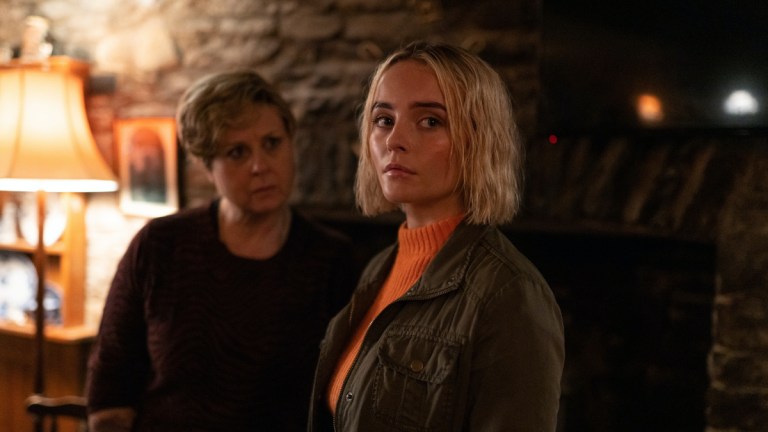Doctor Who Series 14 Episode 4 Review: 73 Yards
When do the rules matter? Millie Gibson excels in a captivating episode that leaves questions unanswered. SPOILERS.

Warning: this Doctor Who review contains spoilers.
Halfway through the frustrating, fascinating “73 Yards”, Kate Lethbridge-Stewart says: “It’s what we do, all of us. We see something inexplicable and invent the rules to make it work.”
Ever since the Doctor inadvertently allowed superstition to seep through at the end of the universe in “Wild Blue Yonder”, the series has been engaging explicitly with the supernatural. From goblins that feast on coincidence and bad luck, to chaos gods weaponising the music within our souls, this focus on the fantastical has opened up many exciting narrative and visual possibilities for Doctor Who. And as Kate points out, in a neat bit of world-building, it hasn’t gone unnoticed – as well as the usual psychic training and telepathic dampeners, UNIT personnel also wear necklaces of silver and salt.
It’s compelling stuff. But as chilling, tense and unpredictable as this episode is – and as welcome as it is to see Millie Gibson excel in centre stage – it also feels like cracks are starting to show in the new approach.
“73 Yards” sees Ruby stranded in Wales, separated from the Doctor when he vanishes after accidentally breaking a clifftop magic charm. His disappearance suspends Ruby along a timeline in which she’s stalked by a mysterious woman who stays at the titular set distance from her, and who sends anyone who approaches her running screaming away from Ruby forever – including mum Carla.
Decades of isolation pass, until Ruby remembers a future “spoiler” the Doctor let slip about dangerous Welsh politician Roger Ap Gwilliam (Aneurin Barnard), and decides to use her unique follower to stop him and save the world from nuclear destruction. Having done so, Ruby lives on and dies of old age, when she is revealed to have been the woman following her. Back in time on the same Welsh clifftop, Ruby warns her younger self, stops the Doctor from breaking the charm, stops that timeline (though presumably nuclear doom still looms come 2046) and the adventures continue. Simple!
Or not. There’s been plenty of discussion about Doctor Who’s engagement with fantasy. For some viewers, their suspension of disbelief began to fray with “The Devil’s Chord”, and its somewhat hand-wavy (no pun intended) approach to Maestro’s powers. What were the rules supposed to be, exactly? I can appreciate the frustration, though it wasn’t a problem for me there, largely because the rules weren’t the focus. The episode wasn’t supposed to be a mystery about the true nature of Maestro’s powers, and there were enough passing references to resonance and the Toymaker’s established “rules of fair play” that your brain could fill in the blanks and let you engage with what was happening without being distracted by questions.
With “73 Yards”, however, the rules are very much the focus. This is a puzzle box episode that sets up a number of questions, with the implication that we will gradually discover the answers as events progress. There is a promise of satisfaction as all the disparate elements snap neatly into place. But while some of the mysteries – like the identity of the old woman following Ruby – are solved, many others – like the fairy circle, its effects and its relationship with the TARDIS – are left woolly and ill-defined. Details that seem significant are left by the wayside in a way that feels unsatisfying. There is simultaneously too much specificity and too much ambiguity.
To pick one example, what exactly does the old woman say to everybody? Sometimes it’s clearly something terrifying, as with Josh and the hiker played by Susan Twist – whose multiple appearances, Russell T Davies has explained, are due to an issue with Equity and a lack of available guest stars, so we can all stop speculating about that. But Ruby’s mother reacts with disgust, and her subsequent interactions with Ruby are cold and contemptuous, rather than terrified. Similarly, Kate Lethbridge-Stewart doesn’t look scared, just disgusted. The overall point seems clear – old Ruby is actively making sure that her younger self stays alone so that she can focus on saving the world – but there’s a disconnect between the explanation of the old woman’s true nature and the specifics of what she does and how she does it, which ends up muddying the waters.
If there was less focus on such details, it wouldn’t matter so much. There is certainly dramatic mileage in leaving things up to the viewer’s imagination, but it feels like a cheat to put so much emphasis on setups, only to deny us payoffs. If Davies is trying to tell us that the emotional journey is what’s important, and the technicalities don’t matter, I’m not sure that’s reflected successfully on screen.
Part of the problem is that the episode is trying to fit too much in, so certain elements feel rushed. I’m never going to criticise Doctor Who for being too ambitious, or for mashing up genres that I wouldn’t have expected to see mashed up – where else could you have 20 minutes of atmospheric, beautifully shot folk horror, then a hard swerve into an unsettling riff on The Dead Zone, before concluding with a melancholy take on the bootstrap paradox? That feeling of never quite knowing what we’re dealing with, the flipping from one genre to the other, the increasingly audacious time jumps, it’s all very exciting.
But it also means that some threads feel short-changed. Roger Ap Gwilliam, no matter how hard the episode tries to sell him as a world-ending threat, never really feels like one. The dystopian future feels too thinly sketched, too similar to our current moment despite it being 2046 (a recurring issue with Russell T Davies’ portrayals of the future, going back to the very first series of New Who). And while the idea of Britain voting for a terrifying fascist is by no means an improbable proposition, I still think said fascist would need a platform that was slightly more substantial than the word ‘nukes’.
Ap Gwilliam’s implied abuse of Marti, and her declaration that “he is a monster”, is certainly skin-crawling – and arguably a bit too grim for this show – and Ruby knowingly allowing that abuse to go on in the name of the mission might be one of the darkest decisions a companion has ever had to make. But overall, the villain just doesn’t get enough screen time to make the necessary impact.
That said, the episode certainly sells Ruby’s sacrifice on a character level, and much of that is down to Millie Gibson. There’s a grand tradition in New Who of ‘Doctor-lite’ episodes, and while this one comes surprisingly early in her run, Gibson still rises to the challenge. It’s no mean feat to maintain centre stage for an entire episode, and she really gets to show her range – terrified, vulnerable, heartbroken, resolute, hard-bitten, sarky. Much like Catherine Tate’s showcase Doctor-lite episode “Turn Left”, it’s an opportunity for actor and character to show their mettle, and in that respect it’s a success.
In fact, there are several echoes here of previous Russell T Davies episodes. The aforementioned Doctor-lite experiments like “Blink”, of course. A bit of “Torchwood: Children of Earth” in the bleakly scathing politics. A sprinkling of “Midnight” in the queasy horror and cynical view of human nature. But there were also points where I found myself thinking – for better and for worse – about “Last of the Time Lords”.
In that divisive finale to series three of New Who, unjustly forgotten companion Martha Jones spends a year separated from the Doctor, travelling a world brought to apocalyptic ruin, navigating God knows what horrors. She survives and saves the world, showing just how capable and courageous she really is. Ruby gets to do much the same here, but over a longer period – she sacrifices everything, her entire life, her emotional connections, in the name of saving the world. She even finds a way to turn the curse of the old lady into a winning strategy, and her decisions all feel real and specific to her character – for one thing, rather than being “The Girl Who Waited”, Ruby turns out to be “The Girl Who Waited … For Two Days, Then Tried To Get On With Her Life”. And fair play to her.
But then, like “Last of the Time Lords”, it’s all undone. In that episode, the Doctor turns back time so that the year of hell never happened. Here, old Ruby travels back in time and somehow manages to communicate a message to young Ruby, stopping the Doctor from breaking the circle and preventing that terrible future from coming to pass. However, unlike “Last of the Time Lords”, nobody remembers any of it. In that episode, the character development we witnessed over 45 minutes still happened, even if the events technically didn’t. In “73 Yards”, apart from an odd feeling of deja vu, Ruby is blissfully unaware of what happened – or what didn’t happen.
On one level, it’s basically like ending the episode with ‘And it was all a dream’. And at least with that hoary old trope, the characters remember the dream! But here, all that courage, all that sacrifice, all that development – coming to terms with loneliness, reconciling her abandonment issues, saving the world – is erased. What are we to make of this? Does character development that didn’t really happen – that only the audience gets to see – still count? Does it still matter?
I’m not even saying I necessarily want Ruby to be haunted by the memory of living a whole life alone in order to defeat Roger Ap Gwilliam. That would be orders of magnitude more traumatic than her ordeal in “Boom”. But the episode leaves us – perhaps appropriately – in a weird liminal state. It happened but it didn’t happen. We remember but they don’t. We want the consequences to mean something, but equally, they’re too awful, and no character we care about should have to bear them.
How frustrating.
How fascinating.
Doctor Who series 14 continues next week with “Dot and Bubble” on BBC One, BBC iPlayer, and Disney+
Learn more about Den of Geek’s review process and why you can trust our recommendations here.
